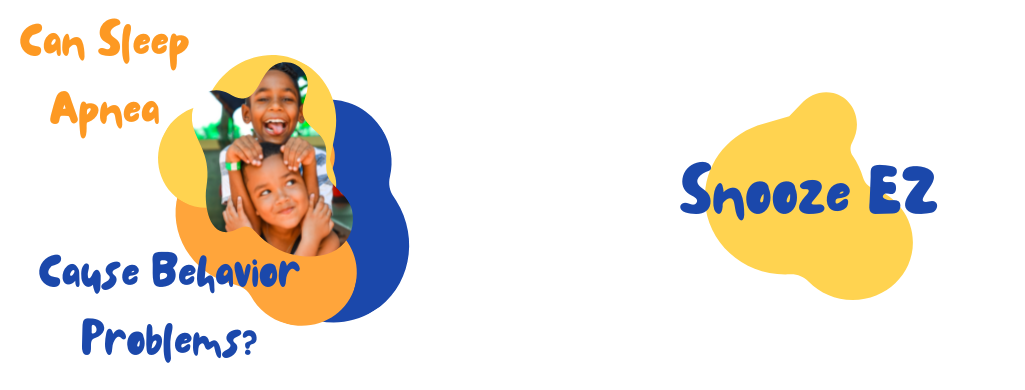Yes, due to poor sleep quality, children can suffer from irritability, mood swings, and other issues.
Sleep is essential for a child’s physical and mental development, so when a child is facing problems such as sleep apnea, it can have serious impacts on their behavior.
Obstructive sleep apnea (OSA) is a condition where breathing repeatedly stops and restarts during sleep due to blocked airways.
Research has shown that this disorder can lead to behavioral problems in children.
In this article, we discuss the causes of sleep apnea and its impact on children’s behavior.
How can sleep apnea cause behavior problems?
Sleep apnea can cause behavior problems due to sleep deprivation and/or poor sleep quality.
Suprisingly, OSA is many times the reason kids are irritable, moody, struggle in school, and lack focus.
Some are even diagnosed with other behavior disorders like ADHD!
The sad reality, they are misdiagnosed without knowing the problem is actually OSA.
Sleep apnea is rarely diagnosed in children, but why? In short, it gets overlooked because they are kids.
Many parents may notice symptoms like snoring and think it is ‘cute’ or ‘funny’ and think they will grow out of it eventually.
Usually, this is not true. Only a very small percentage of children grow out of OSA symptoms or the blockage itself.
What behavior issues are caused by OSA?
Due to interrupted sleep that sleep apnea causes, lack of sleep affects the brain in many scary ways, including behavior.
Behavior issues that OSA can cause are:
- Unable to stay awake during the day
- Can’t focus or concentrate
- Irritable and mood swings
- attention deficit disorder
- disruptive
- hyper intervals
- lack communication, social, cognitive, and emotional skills
- hygiene and self-care issues
- depression
Student performance will more than likely be lacking in school as well. Research shows that children were 7 times more likely to have learning issues and 3 times more likely to make C grades or worse compared to children without sleep apnea.
What Causes Sleep Apnea in Kids?
According to the American Academy of Sleep Medicine, OSA is found in around 2% of babies and children.
There is other research that suggests up to 4%. Though, with it going undiagnosed in so many, the real percentages are unknown.
So, what causes OSA in children?
- Tonsils and/or adenoids – these are commonly removed in children and could be causing the airway blockage
- Obesity – like adults, children who are overweight are at more risk of OSA
- Genetic – family history plays a part in the risk of of OSA
- Skull and face structure – can cause airway blockages. An ENT can help.
Symptoms of OSA in Children
Other than the behavioral symptoms mentioned above, symptoms of sleep apnea are:
- Snoring – the no. 1 symptom. Pay attention to any pauses in breathing while your child snores.
- Waking Frequently – Or do you notice them being restless consistently while sleeping?
- Lack of Development – OSA affects growth hormones
- Mouth Breathing
- Night Sweating
- Frequent Urination at Nighttime
- Enlarged Tonsils and/or Adenoids
- Frequent Bedwetting
- Headaches Upon Waking
- Always Tired
Treatment for Sleep Apnea in Children
Lifestyle Changes
First, some simple lifestyle changes may be recommended by your child’s doctor, such as losing weight or being treated for allergies.
Seeing an ENT Specialist
If lifestyle changes are not the issue, then many children are treated for sleep apnea by being referred to an ENT.
An ENT specialist can help diagnose and identify the reason for the blockage.
Generally, this could be an easy procedure to correct the issue, like removing enlarged tonsils and adenoids for example. Regardless an ENT will know what to do.
CPAP Therapy
In more rare circumstances, children may need to start CPAP (continuous positive air way pressure) treatment. This is seen being used more by adults, but is very successful in treating OSA.
This consists of a mask and a machine that produces pressured air through the mask that the child would wear every night while they sleep.
Conclusion
Sleep apnea is a dangerous condition that, if left untreated, can have serious consequences. In children, misdiagnosis of this condition can lead to long-term developmental issues and even death in extreme cases.
Unfortunately, the signs and symptoms associated with sleep apnea are often overlooked in kids which can lead to misdiagnosis or delayed diagnosis.
Sleep apnea occurs when breathing stops temporarily during sleep due to obstruction or narrowing of the airway.
In children, this can be caused by enlarged tonsils and adenoids blocking the airways. Furthermore, other factors such as obesity, allergies, sinus infections and medications may also contribute to the development of sleep apnea in kids.
If left undiagnosed or mistreated, it may result in long-term health effects including poor concentration and disruption of growth hormones.


